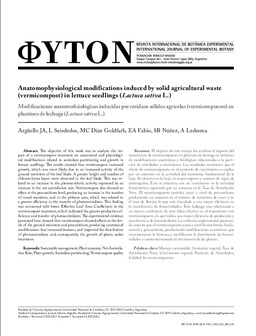| dc.contributor.author | Argüello, Juan Alberto | |
| dc.contributor.author | Seisdedos, Lina | |
| dc.contributor.author | Díaz Goldfarb, María del Carmen | |
| dc.contributor.author | Fabio, Ernesta Andrea | |
| dc.contributor.author | Núñez, Selva Beatriz | |
| dc.contributor.author | Ledesma, Alicia | |
| dc.date.accessioned | 2022-05-09T15:04:44Z | |
| dc.date.available | 2022-05-09T15:04:44Z | |
| dc.date.issued | 2013 | |
| dc.identifier.citation | Argüello, J. A., Seisdedos, L., Díaz Goldfarb, M. C., Fabio, E. A., Núñez, S, B. and Ledesma, A. (2013). Anatomophysiological modifications induced by solid agricultural waste (vermicompost) in lettuce seedlings (Lactuca sativa L.). Phyton. International Journal of Experimental Botany, 82, 289-295. http://www.revistaphyton.fund-romuloraggio.org.ar/vol82/ARGUELLO.pdf | |
| dc.identifier.uri | http://hdl.handle.net/11086/24714 | |
| dc.identifier.uri | http://www.revistaphyton.fund-romuloraggio.org.ar/vol82/ARGUELLO.pdf | |
| dc.description.abstract | The objective of this work was to analyze the impact of a vermicompost treatment on anatomical and physiological
modifications related to assimilate partitioning and growth in lettuce seedlings. The results showed that vermicompost increased
growth, which was most likely due to an increased activity of the ground meristem of the leaf blade. A greater height and number of chlorenchyma layers were observed in the leaf blade. This was related to an increase in the photosynthetic activity, expressed by an increase in the net assimilation rate. Vermicompost also showed an effect at the procambium level, producing an increase in the number of vessel members, and in the phloem area, which was related to a greater efficiency in the transfer of photoassimilates. This finding was connected with lower Effective Leaf Area Coefficients in the vermicompost treatment, which indicated the greater production efficiency and transfer of photoassimilates. The experimental evidence presented here showed that vermicompost showed effects at the levels of the ground meristem and procambium, producing anatomical modifications that increased biomass, and improved the distribution of photoassimilates and, consequently, the growth of plants under
treatment. | en |
| dc.description.abstract | El objetivo de este trabajo fue analizar el impacto del tratamiento de vermicompuesto en plántulas de lechuga en términos de modificaciones anatómicas y fisiológicas relacionadas a la partición de asimilados y crecimiento. Los resultados mostraron que el efecto de vermicompuesto en el aumento de crecimiento se explica por un aumento en la actividad del meristema fundamental de la hoja. Se observó en la hoja un mayor espesor y número de capas de clorénquima. Esto se relaciona con un incremento en la actividad fotosintética, expresado por un aumento en la Tasa de Asimilación Neta. El vermicompuesto también actuó a nivel de procambium, produciendo un aumento en el número de miembros de vasos y en el área de floema, lo que está vinculado a una mayor eficiencia en la transferencia de fotoasimilados. Este hallazgo está relacionado a un menor coeficiente de área foliar efectiva en el tratamiento con vermicompuesto, lo que indica una mayor eficiencia de producción y transferencia de fotoasimilados. La evidencia experimental presentada muestra que el vermicompuesto actuó a nivel de meristema fundamental y procambium, produciendo modificaciones anatómicas que incrementaron la biomasa y modificaron la distribución de fotoasimilados y consecuentemente el crecimiento de las plantas. | es |
| dc.language.iso | eng | es |
| dc.rights | Atribución 4.0 Internacional | * |
| dc.rights.uri | http://creativecommons.org/licenses/by/4.0/ | * |
| dc.source | Phyton. International Journal of Experimental Botany, 2013; 82, 289-295 | |
| dc.source | ISSN: 1851-5657 | |
| dc.source.uri | http://www.revistaphyton.fund-romuloraggio.org.ar/index.html | |
| dc.subject | Lechuga | es |
| dc.subject | Lombricompuesto | es |
| dc.subject | Anatomía de la planta | es |
| dc.subject | Crecimiento de la planta | es |
| dc.title | Anatomophysiological modifications induced by solid agricultural waste (vermicompost) in lettuce seedlings (Lactuca sativa L.) | es |
| dc.type | article | es |
| dc.description.version | publishedVersion | es |
| dc.description.fil | Fil: Argüello, Juan Alberto. Universidad Nacional de Córdoba. Facultad de Ciencias Agropecuarias. Cátedra de Fisiología Vegetal; Argentina. | es |
| dc.description.fil | Fil: Seisdedos, Lina. Universidad Nacional de Córdoba. Facultad de Ciencias Agropecuarias. Cátedra de Botánica Morfológica; Argentina. | es |
| dc.description.fil | Fil: Díaz Goldfarb, María del Carmen. Universidad Nacional de Córdoba. Facultad de Ciencias Agropecuarias. Cátedra de Fisiología Vegetal; Argentina. | es |
| dc.description.fil | Fil: Fabio, Ernesta Andrea. Universidad Nacional de Córdoba. Facultad de Ciencias Agropecuarias. Cátedra de Fisiología Vegetal; Argentina. | es |
| dc.description.fil | Fil: Núñez, Selva Beatriz. Universidad Nacional de Córdoba. Facultad de Ciencias Agropecuarias. Cátedra de Fisiología Vegetal; Argentina. | es |
| dc.description.fil | Fil: Ledesma, Alicia. Universidad Nacional de Córdoba. Facultad de Ciencias Agropecuarias; Argentina. | es |





